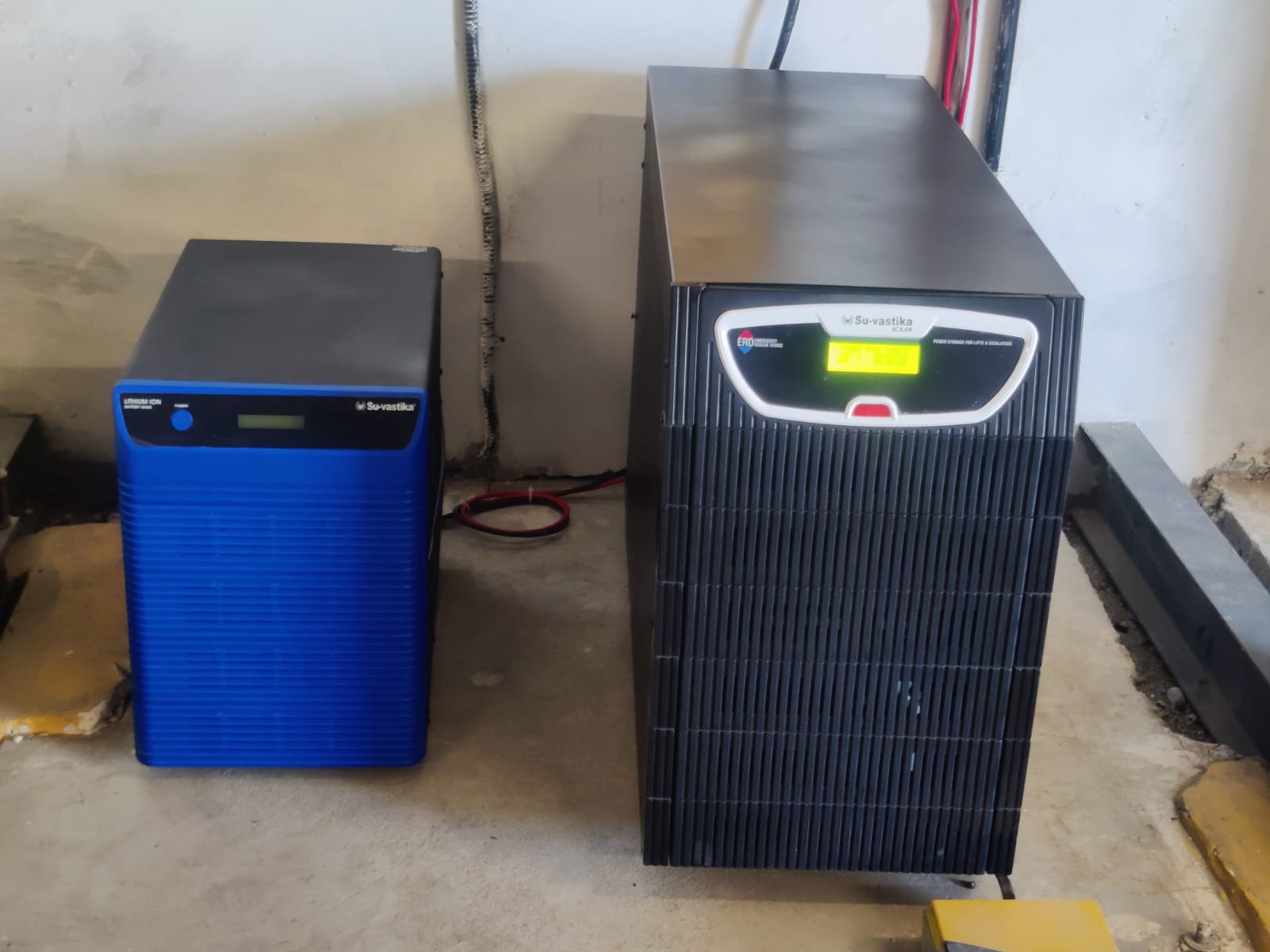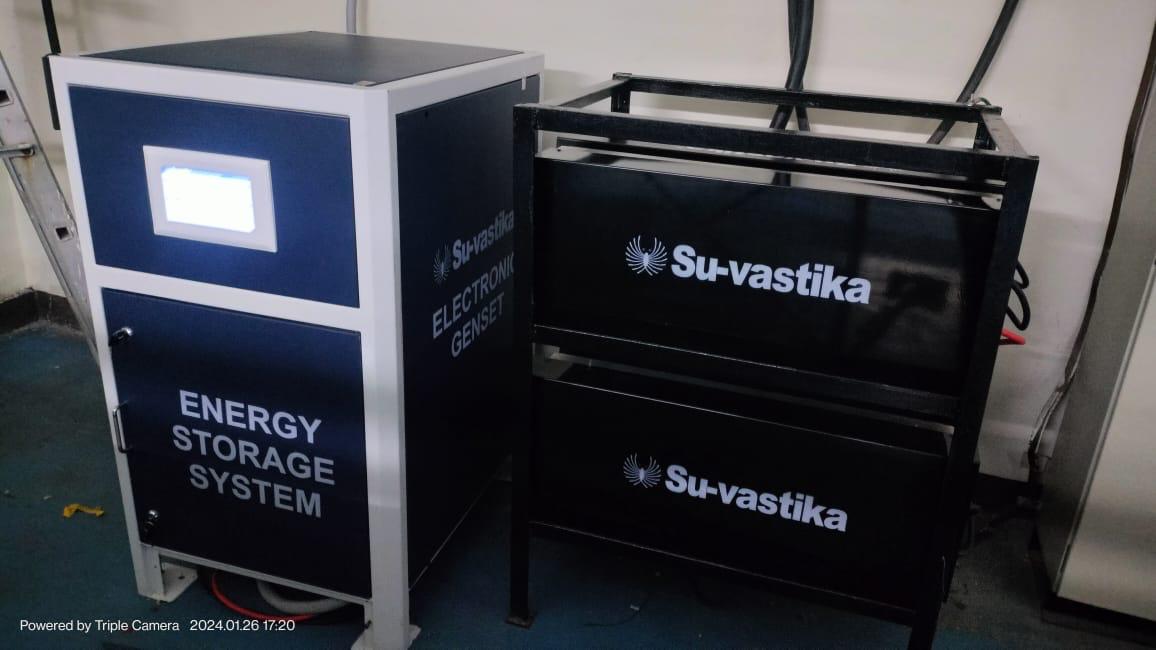
The Solar charge controller is the device that helps charge the battery through the solar panels. This device is important for charging the battery through Solar panels and is called a solar charger or solar charge controller.https://en.wikipedia.org/wiki/Solar_charger
Let us understand in detail: Solar panels are a DC device, and the battery is also a DC device so we can charge the battery through solar panels directly. What will happen if we charge the battery directly through solar panels? Solar panels have high voltages compared to battery voltages. So let us take the example of the solar panel of 150 Watt which has a VOC or Open Circuit voltage of around 22 to 23 Volts and a battery voltage is 12 Volts, so when we try to charge the battery then, we need to stop the Tubular/SMF Lead Acid battery boost voltage at 14.4 Volts, and then we need to charge the battery Float mode where we need to reduce the battery voltage to around 13.6 Volts and charge it at a prolonged current so that the battery’s gravity is made to get the full back up from the battery. In this condition, we can’t generate directly from the solar panels as the voltage is very high in solar panels, so they will charge the battery and take it to 17 to 18 volts which will be the overcharging stage for any battery since the solar panels have no control of cutting the battery charging at a fixed voltage so the solar panel will charge the battery straight to the higher voltage which will damage the battery after few charge-discharge cycles. Another factor is when the load is applied to the battery. The battery will start discharging, and there is no such control of the LVC Low Voltage cutoff, which is an important factor in saving the battery from deep discharge. Another factor is matching the solar panel with the battery to charge. We need 10% of the battery capacity to charge the battery. So in the case of a 150 Ah battery, we need to charge it with a maximum of 15 Amps, and if we try to charge with a higher current, then the lead Acid battery will charge faster. There will be a battery water loss, and the life of the battery will be compromised if try to charge the battery with a very high current, like 50 or 60 Amps, to a Tubular battery 150 Ah battery then the battery will be charged in less than 3 hours and can also blast as we are charging it with a very high current.

Solar Panel Configuration for 12V Solar Hybrid PCU with MPPT
All these three issues are taken care of by the solar charge controller. So solar charge controllers reduce the charging Current as per its capacity. So if the charge controller is made for 15Amps current, then it will not let more current pass through it and will stop the Current to the battery in case someone tries to give more Current through the solar panels and will save the battery from being harmed. It has the mechanism not to charge a single battery of 12 v beyond 14.4 volts or whatever the manufacturer sets the fixed voltage. So in the case of 24 volts, the general setting is done for 28.8Volts and 48-volt system, the setting is done for 57.6 volts. So every charge controller has a voltage limit to pass through, after which it gives the warning, stops functioning, and saves the battery life and overcharging.
In the same way, the low battery cutoff or LVC of the battery is controlled through the solar charge controller to save the battery from deep discharge. Another important feature of the solar charge controller is to have the ATC Automatic temperature compensation to take care of the Lead Acid battery to control the boost voltage according to the temperature so that the Lead Acid battery can give the proper backup time in winter and in summers battery boost voltage is reduced to save the electricity bill and the life of the battery. Another function of the charge controller is to stop the current flow from the battery to the Solar panel. As both are DC devices, the current flow will happen on both sides, so at night, if the battery starts giving current back to the solar panel, it might damage the solar panels. So there is a diode which controls the flow of power from the solar panel to the battery and doesn’t let the current flow back the Current to the solar panel through the battery.
Now PWM stands for Pulse Width Modulation, and the charge controller is a simple charge controller circuitry which provides the power from the solar panels to the battery. Almost a 30 to 60% loss happens when it charges the battery. For example, let us take the 12-volt battery charging through the solar panel, which has a VOC of 22 volts. So to make it 150 Watt panel, it gives approximately 7Amps Current from the board. Now the PWM charge controller will reduce the voltage as per the battery voltage to charge it, so if the battery is fully discharged, the solar charge controller will reduce the voltage to 10.5 Volts from 22 Volts VOC. Some current will also be lost through the PWM charge controller, which will be approximately 1 to 1.5 Amps depending upon the quality of the charge controller, so we take 1 Amp loss, and the voltage reduction of 10.5 Volts then the total wattage which goes to charge the battery will be 10.5X6=63 Watt so the wattage of panel being wasted at this stage will be almost 60% and the same way we can calculate the wattage going to charge the battery on 12v,13V and 14V. so once the battery reaches to the 12V than 12X6=72Watt which is 50% of the panel wattage. So once the battery reaches 14V, it becomes 14X6=84Watt, the maximum peak wattage used for the battery charging, and the rest of the panel capacity is wasted.https://suvastika.com/how-to-match-the-solar-panel-voltages-and-battery-voltage-in-solar-hybrid-pcu/
The maximum waste of panel wattage happens when the charge controller charges the battery into the Float mode as the battery voltage reaches 14.4 Volts, the charging current reduces to 2 to 3 Amps for reducing the battery voltage, and it charges the battery very slowly to make the gravity of the battery. So let us calculate the battery voltage reduced to 13.8X2=27.6 watts. The float mode for the battery is a slow charging concept, and this is the lowest output we get from the PWM solar charge controller. So there are three stages of charging Bulk, Absorption and Float charging, which are important for the Lead Acid battery. If any manufacturer does not put these conditions in their solar charge controller along with the ATC feature, then the life of the battery will be reduced. There might be more battery water loss and heating inside the battery. Nowadays, the manufacturer designing the PCU tries to make it for 60 to 70 Amp solar charge controller without any stages and protection where the user can install more panels to charge batteries. They spread the rumours in the market that their Solar PCU does the sharing while charging the battery, and the battery charging will be shared with the load. So they tell the dealers to install more panels on the solar PCU, resulting in higher current charging of batteries. The battery life is reduced, the battery water topping has increased, and there are places where battery blasts are also happening. Ultimately the customer is complaining that the electricity bill has increased after installing Solar PCU as the solar and the Grid are charging the batteries.
The MPPT or Maximum Power Point Tracking Charge controller has complex circuitry, which increases the Current coming from the solar panels and increases the efficiency of the solar panel, which is lost in the PWM charge controller. Maximum power point tracking – Wikipedia
The MPPT tracks the voltage and Current from the solar panel to determine when the maximum power occurs to extract full control. The MPPT then adjusts the voltage to the battery to optimize the charging. This results in a maximum power transfer from the solar module to the battery. The MPPT charge controllers are 30% more efficient than the PWM-based ones.
For Lithium batteries, the solar charge controller needs different boost voltages to charge, and the low battery cutoff is also different. The lead Acid battery charging is very complex, has minimum three-stage charging, and needs ATC. But for Lithium, there is no such complexity is required, but the boost voltage and low battery cutoff settings are different,






